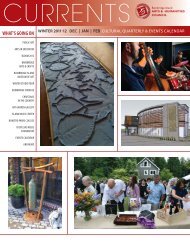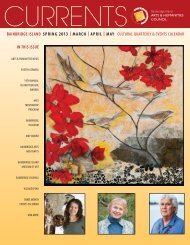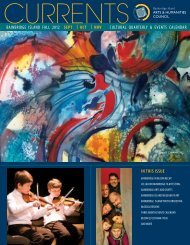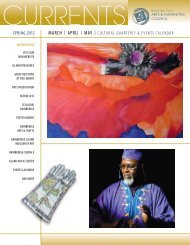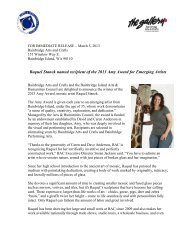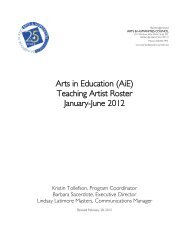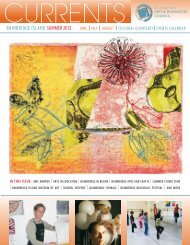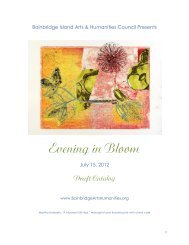Winter 2012-2013 edition - Bainbridge Island Arts & Humanities ...
Winter 2012-2013 edition - Bainbridge Island Arts & Humanities ...
Winter 2012-2013 edition - Bainbridge Island Arts & Humanities ...
Create successful ePaper yourself
Turn your PDF publications into a flip-book with our unique Google optimized e-Paper software.
and social practice<br />
Amidst the broad spectrum of engagement revealed<br />
through this community of artist-educators, core<br />
themes also surfaced: Firsthand involvement in<br />
creative practice helps people transcend embedded<br />
limitations of communication; teaching artists act<br />
as conduits for student discovery and facilitators of<br />
the learning process; and regardless of the artistic<br />
discipline practiced, teaching artistry attunes<br />
participants to a transformative magic that shapes<br />
the way they look at the world.<br />
These consistent themes have broad implications.<br />
When teaching artists ply their crafts, they cultivate<br />
real listening; they hear the desires of their community<br />
of learners and involve them in the process. This act in<br />
turn cultivates a form of learning stewardship, a grassroots<br />
investment made by participants who find and<br />
voice their strengths.<br />
Eric Booth, an international leader on the topic of<br />
teaching artistry, articulates the importance of this<br />
transformation in his book The Everyday Work of Art:<br />
“We need to attend to the artistic experiences<br />
throughout our lives… In doing so, we reclaim<br />
many dwindling passions; we awake dormant<br />
skills with which to construct good answers to life’s<br />
hardest questions. We all have a natural knowledge<br />
of the processes and perspectives that artists<br />
use, even if we have not focused our efforts on<br />
developing these skills the way artists have.”<br />
This conviction is not restricted to conversations<br />
about the arts. Across the board, in discussions ranging<br />
from environmental concerns to social justice, creative<br />
engagement is the constant.<br />
The fusion of learning and teaching, individuals and<br />
communities, and the affirmation of the core impact<br />
of arts in society I experienced during the Oslo<br />
conference had a profound impact on me. I came<br />
away both grounded – by a greater commitment to<br />
my own work and its ability to support community –<br />
and buoyed by witnessing firsthand ways in which<br />
the methods of teaching artistry support an embracive<br />
way of navigating the world.<br />
BAINBRIDGE ISLAND ARTS & HUMANITIES COUNCIL<br />
“[The arts] are a very human way of making life more<br />
bearable. Practicing an art, no matter how well or<br />
badly, is a way to make your soul grow….”<br />
~ KuRt VoNNEGut<br />
I was reminded of the words of Kurt Vonnegut, who said,<br />
“[The arts] are a very human way of making life more<br />
bearable. Practicing an art, no matter how well or badly,<br />
is a way to make your soul grow."<br />
And in these days of reconfiguring economies,<br />
remembering how to work together, and advocating for<br />
the cause of humanity, it is critical that we all draw upon<br />
these innate creative and inclusive capacities.<br />
Kristin Tollefson is an internationally recognized artist and teaching<br />
artist who is also the program coordinator for the <strong>Arts</strong> & <strong>Humanities</strong><br />
Council’s <strong>Arts</strong> in Education program. She lives on <strong>Bainbridge</strong> <strong>Island</strong>.<br />
photoS, LEFt to RIGht: Richard Ndunguru, of tanzania, leads an international group of conference<br />
participants in a call and response exercise. his program, theater for Development, moves community<br />
participants toward social change through the act of storytelling. Photo: Maria Antwort. Marit Moltu's<br />
participatory yarn installation; Kristin tollefson appears sixth from the left. Photo: Maria Antvort. In<br />
hilary Easton's dance workshop, participants choreographed works to illustrate lines, angles, curves, and<br />
moments of stillness. Photo: Kristin tollefson.<br />
With many thanks to our <strong>Arts</strong> in Education sponsors and partners:<br />
THE SUQUAMISH TRIBE<br />
ARTS & HUMANITIES COUNCIL<br />
CURRENTS WINTER <strong>2012</strong>-<strong>2013</strong> 5



